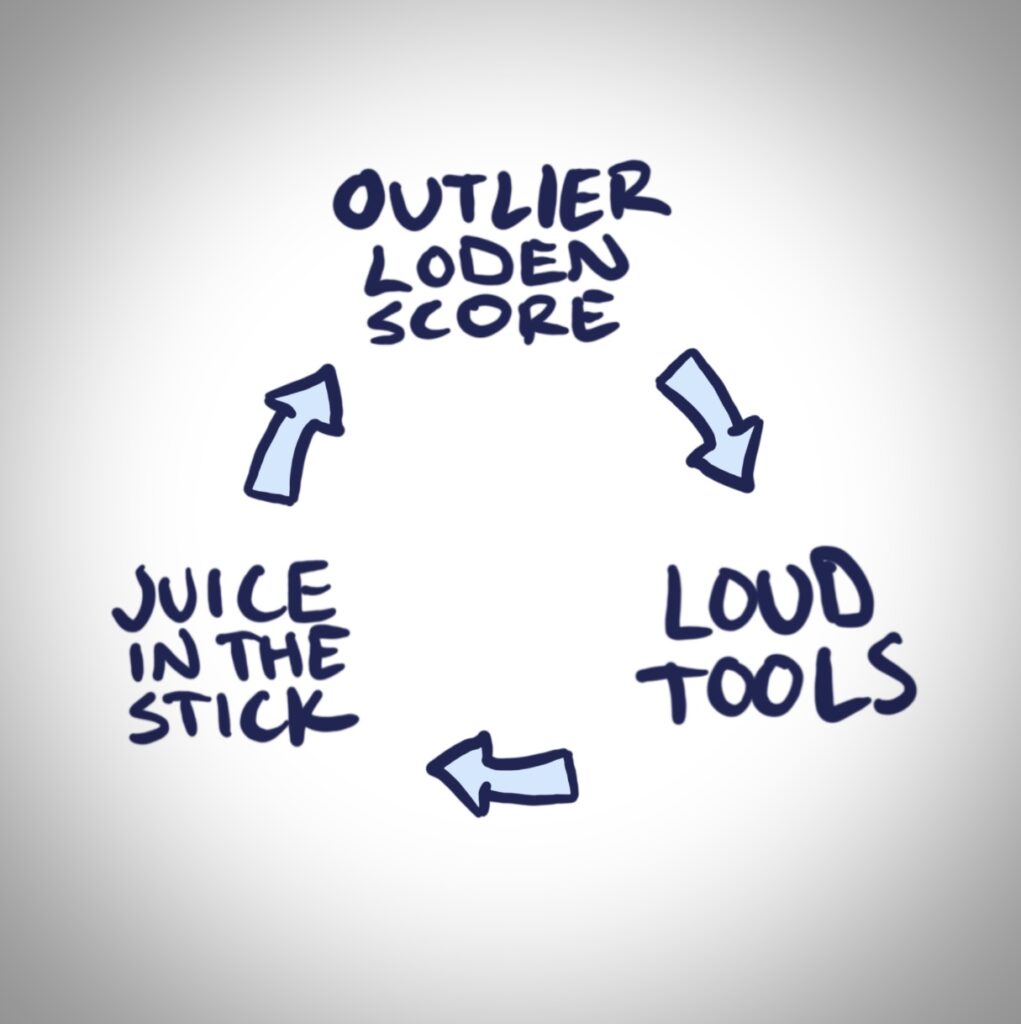
A Perspective on Athleticism
There is no universal definition of athleticism. Ask 10 people the definition of athleticism and you’ll get 10 different answers. For that reason, it is often hard to quantify. Before we go any further, we would like to share our frame of mind: there are two halves of an athlete – raw athleticism and sport-specific skill. Loden Sports evaluates raw athleticism and it is up to talent evaluators to determine whether the athlete possesses enough ability to play their sport (and psychological make-up, team-fit, etc.).

Athletes like Tom Brady and Stephen Curry have overcome moderate raw athleticism to have great success as a result of outlier, sport-specific skill. Conversely, Russell Westbrook and Lamar Jackson have achieved great success with outlier, raw athleticism and moderate, sport-specific skill. In rare cases, an athlete has both outlier sport-specific skill and outlier raw athleticism: LeBron James and Mike Trout.

We have all seen it time and again: wide receivers drafted high in the NFL Draft off of their freakish speed that can’t run routes or catch passes at an NFL level; baseball players signed for their loud tools that don’t hit; the guy who throws 100, but can’t throw strikes. Often times, the fan base views this as a bust or a poor signing. What they may not consider is that it is a risk worth taking. While the fastest player in the 2009 NFL Draft, Darrius Heyward-Bey, may not have ascended to the glory; Tyreek Hill has become one of the most indefensible players in the sport’s recent memory. While a pitcher who threw 100-mph, Pat Light, was never able to carve out an MLB role; Jacob deGrom, paired with his 100-mph fastball, will go down as one of the best we’ve ever seen. It’s risk-reward. If it clicks for the outlier athlete, the reward is much greater – for the team and for the fanbase.
A simplification: Sport-specific skill determines the usefulness of the athlete within their sport. Raw athleticism determines the ceiling for what they can become.
Alright, enough painting the picture…
Loden Sports has evaluated thousands of elite, physically mature athletes and can convey objectively on a simple 0-12 scale (the Loden Score System) whether an athlete is below average, average, above average, or an outlier. The Loden Score System is comprised of a Power, Quickness, Speed, and an overall Loden Score. An average score in any category for an elite, physically mature athlete is a 6.
The Power, Speed, and Loden Score metrics have all been found to be heavily correlated to throwing velocity, exit velocity, and bat speed – and in addition to talent identification, can be used for the purposes of monitoring expected performance and fine-tuning routines.
Who is Spencer Jones?

After appearing in just 48 games between the COVID-shortened 2020 season and a 2021 season that saw Spencer Jones get a late start due to recovery from reconstructive UCL surgery, he’s made up for any lost time and then some, while performing on the two toughest amateur circuits: SEC Conference Play and the Cape Cod Baseball League. Spencer just finished his junior year at Vanderbilt University where, in SEC play, he batted .354 with 15 extra-base hits in 30 games, a .459 OBP, and an OPS north of 1.000, (.370 BA / .460 OBP / 1.103 OPS overall). This follows a summer on the Cape where he hit .312 with a .905 OPS for the 2021 CCBL Champion Brewster White Caps.
On June 9, 2022 in Nashville, Tennessee, in advance of his participation in the 2022 MLB Combine, Loden Sports evaluated Vanderbilt outfielder Spencer Jones to objectively measure his raw athleticism. The evaluation took place between 11am-12pm local time. Jump testing was performed in the weight room and sprint testing was performed on Vanderbilt’s game field.
*Spoiler Alert* He’s an Outlier.
Spencer measured in at 6-7 and weighed 228.3 lbs. After a warm-up, Spencer performed, in order: a Counter Movement Jump test, 5 Single Leg Jumps on his left leg, and then his right leg, and a second trial of the Counter Movement Jump test. Following jump testing, Spencer took 15 minutes to warm-up prior to performing two, 30-yard sprints on the game field. Finally, the data collected during the evaluation was inputted into the Loden Sports scoring mechanism and out came Spencer’s results:

Loden Sports classifies any athlete with a Loden Score of a 9 or higher as an outlier athlete.
- Okay, that’s great, more context please.
Of the thousands of elite athletes Loden Sports has tested, less than 1% (.82% to be exact) have achieved a Loden Score of 9 or higher.
- Congrats, Spencer… you’re a 1%’er.
But wait, there’s more…
There are a number of ways to get to a Loden 9, you could be top of the scales fast and slightly above average in the power department or you could be top of the scales in power and a slightly above average runner. What makes Spencer even more unique…
- More unique than 1%?
Just .22% of all athletes that Loden Sports has tested have achieved a 9 or higher in both Power and Speed. Spencer is a special breed of unique: he’s the top-end power and speed combo.
- Alright, we get it, this guy is special.
We’re not done yet! While it is impressive that Spencer is an outlier athlete against the entire elite population, it begs the question of how he compares to other athletes of his size. Don’t forget that he’s 6-7, 228.3 lbs.
- Okay, so how does he compare to other athletes his size?
Loden Sports has created a way to not just compare elite athletes to the entire pool, but also to other elite athletes in their height and weight buckets. This was created as a way to objectively show that while most athletes of a certain size or body type may perform a certain way, they are all wired differently – looking at you Corbin Carroll – the “undersized” guy with serious juice who also happens to be, you guessed it, an outlier, (reference approved by Corbin Carroll).
We’ve found that the Loden Score System is a particularly useful tool for validating why certain guys outperform their body bias.
Loden Sports categorized the elite, physically mature athlete sample by their height (short, average, tall) and weight (small, average, large). The “Short-Large” and “Tall-Small” buckets weren’t necessary (no one fell into those categories), so, that leaves seven unique buckets with thresholds outlined below:

At his height and weight, Spencer falls into the “Tall-Large” bucket for comparison and as you can see below, the average “Tall-Large” athlete is a power heavy profile, to which Spencer still exceeds by a point. Furthermore, he has a point on the average “Tall-Large” athlete in Quickness; 4 points on Speed; and 3 points on his Loden Score.

A simplification: Guys his size don’t run like he does.
For further reference, the body types with the fastest average Speed score (7) of all the body types are “Short-Small” and “Average-Small.” And he exceeds athletes in those buckets by 2 points each.
So, against the whole elite, physically mature population, Spencer Jones is an outlier. Peeling back another layer of the onion, he outperforms athletes of his body type – notably in Speed.
Let’s Close the Loop
Let’s put it all together.
As we mentioned before, the Loden Score System correlates heavily to things like throwing velocity, exit velocity, and bat speed. Spencer achieved a 9 Power, 6 Quickness, 9 Speed, and 9 Loden Score – and as we think we’ve made clear – he’s objectively an outlier.
- So, is it any surprise at all that he put 22 balls in play this spring with an exit velocity over 110 mph?
- Or, that nearly half of the balls he put in play this year came off the bat over 100 mph (45% to be exact)?
- For people tied into baseball analytics, it’s pretty common knowledge that as launch angle increases, exit velocities tend to decrease – yet, Spencer averaged 99.1 mph on balls launched between 26-45 degrees (categorized as fly balls).

Loop closed; it all makes sense.
In Regards to the 2022 MLB Draft
With less than 1% of the elite, physically mature athlete population scoring a Loden 9 or higher, it is hard to imagine that Spencer Jones isn’t one of the best athletes in the entire draft class. Couple his outlier raw athleticism with his size and you have a size-power-speed combo usually reserved for the upper reaches of basketball and football. It is no secret that baseball is seeking a higher caliber of athlete to inject excitement into the sport… we can’t help but wonder if Spencer Jones wasn’t born in Southern California, a baseball hotbed – would he have been playing tight end for Nick Saban or Dabo Swinney instead of patrolling right field for Tim Corbin?

We’ve talked about body bias; it exists in talent identification for all sports. For two years at Vanderbilt, Spencer shared an outfield with center fielder, Enrique Bradfield – the fastest player in college baseball and a member of the 2021 ABCA/Rawlings Division 1 Gold Glove Team. In how many other Division 1 outfields would Spencer have been patrolling center field?
Some will knock him for his size…
“Guys his size don’t play center field”
…but as we’ve objectively observed, he’s an outlier.
Outliers can do things that the average can’t.
Sports are fueled by outliers of all shapes and sizes: sometimes it’s exceptional skill like Tom Brady or Stephen Curry; sometimes it’s exceptional athleticism like Russell Westbrook or Lamar Jackson. No matter how you slice it, people watch sports to see athletes that can do things that the average human being can’t.
Spencer Jones possesses a critical piece of that puzzle and his ceiling is as high as anyone.
Notes
- Spencer provided 10-yard / 30-yard run splits captured during testing while he was a member of the USA Baseball 17U National Team Development Program on July 24, 2017 for comparison. In 2017, Spencer had splits of 1.83 / 3.99 (sec). During the Loden Sports evaluation on June 9, 2022, Spencer ran twice, recording splits of 1.75 / 3.86 (sec) and 1.73 / 3.81 (sec) – video embedded above.
- Thank you to the Vanderbilt University baseball program for providing access to his batted-ball data for the 2022 spring season.
- Loden Sports Objective Performance Benchmarks: this resource covers benchmarks and age-norms for metrics that Loden Sports represents in its post-evaluation report to athletes, parents, coaches, and administrators.
- Loden Sports stands by its practices of delivering consistent-to-the-detail instruction for every evaluation. For more information on the best practices that Loden Sports employs for collecting reliable data, we wrote about it.
- Contact Loden Sports via email: info@lodensports.com





